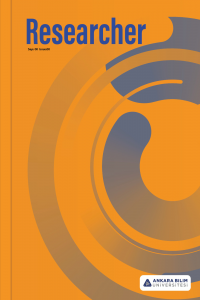“Matelasse” Kumaşlar ve Özellikleri
“Matelasse” Fabrics and Properties
___
- Ashenhurst, T. R. (1883). Design in Textile Fabrics. Cassel & Company, Limited, London, Paris, NewYork.
- Başaran, F. N. (2020). Bileşik Yapılı Dokuma Teknikleri. Karınca Ajans, Bizim Büro Basım Evi Yayın ve Dağıtım Hizmetleri San. Tic. Ltd. Şti. Ankara.
- Başer, G. (2005). Dokuma Tekniği ve Sanatı. Cilt 2 Dokuma Kumaş Tasarımı. Punto Yayıncılık Ltd.Şti. İzmir.
- Berber, G. Ş. (2019). Dokuma Kumaşlarda Rölyef Etkiler ve Deneysel Çalışmalar. Yayınlanmamış Doktora Tezi, Gazi Üniversitesi Güzel Sanatlar Enstitüsü. Ankara.
- Berber, G. Ş. ve Başaran, F.N. (2018). Rölyef Etki Açısından Dokuma Kumaşlarda İplik. Hars Akademi Uluslararası Hakemli Kültür-Sanat-Mimarlık Dergisi, Sayı 1(1), 57-68.
- Brannock, R.W. (1965). Heat Puffing Of a Cured Latex Coated Fabric of Cotton and Thermoplastic Fibers. U.S. Patent No. 3,178,498. Washington, DC: U.S. Patent and Trademark Office.
- Cavalier, S. J. and Raper, L. B., & Walker, Harold B. (1971). Filled Cushion Matelasse Fabric and Method. U.S. Patent No. 3,553,066. Washington, DC: U.S. Patent and Trademark Office.
- Dölen, E. (1992). Tekstil Tarihi. Marmara Üniversitesi Teknik Eğitim Fakültesi Yayınları No:92/1. Matbaa Eğitimi Bölümü Yayın No: 6. 608 s., İstanbul.
- Galatioto, L. C. (1971). Method of Treating Knitted Synthetic Fabrics to Simulate Matelasse Cloth and Resulting Products. U.S. Patent No. 3,598,513. Washington, DC: U.S. Patent and Trademark Office.
- Gooch, J. W. (2011). Encyclopedic Dictionary of Polymers. USA: Atlanta.
- Gürcüm, B. H. (2010). Dokuma Kumaşların Öznel Algısı ile Bazı Fiziksel Özellikleri Arasındaki İlişkinin Belirlenmesi. Tekstil ve Konfeksiyon, 2, 101-108.
- Halaçeli, H. (2009). Elastan İçeren Dokuma Kumaşlarda Üç Boyutlu Yaklaşımlar. Sanatta Yeterlik Tezi, Dokuz Eylül Üniversitesi Güzel Sanatlar Enstitüsü. İzmir.
- Halaçeli M., H. (2015). Günümüz Dokuma Kumaş Tasarımında Deneysel Yüzey Araştırmaları. Anadolu Üniversitesi Sanat ve Tasarım Dergisi, Cilt 5, No. 13, 88-111.
- Howorth, W.S. and Oliver P.H. (1958). The Application of Multiple Factor Analysis To The Assessment of Fabric Handle. Journal of the Textile Institute, 49, pp. 540-553. İmer, Z. (1989). Dokuma Tekniği 2. Sistem Ofset: Ankara.
- McKinnon, B.; Land, F. J. and Handermann, A. C. (2007). Flame Resistant Matelasse Fabrics Utilizing Spun and Filament Flame Resistant Yarns. U.S. Patent Application No 11/436,023.
- Schoeser, M. (1995). International Textile Design. Laurence King Publishing. London. Sytz, R. M. (2012). Enhanced Knit Fabric Fire Barrier for Mattresses. U.S. Patent Application No 13/440,775.
- Taylor, L. B. (1952). What do you know about Fabrics? Journal Design, 53(4), 84-85.
- Yıldırım, L. (2007). Günümüz Ev Tekstili Tasarımını Etkileyen Faktörlerin Saptanması ve Türk Ev Tekstilindeki Durumu. Yayınlanmamış Doktora Tezi. Dokuz Eylül Üniversitesi Güzel Sanatlar Enstitüsü. İzmir.
- URL-1- https://www.wikizeroo.org/index.php?q=aHR0cHM6Ly9lbi53aWtpcGVkaWEub3JnL3dp a2kvTWF0ZWxhc3PDqQ (Erişim Tarihi: 21.12.2019)
- URL-2-https://www.batesmillstore.com/blogs/news/120896327-the-history-of-matelasse (Erişim Tarihi: 30.09.19)
- URL-3-http://collections.vam.ac.uk/item/O98183/the-tristan-quilt-bed-cover-unknown/ (Erişim Tarihi: 21.12.2019)
- URL-4-https://tr.ecobuilderz.com/what-is-matelasse-fabric-10563 (Erişim Tarihi: 30.09.19)
- URL-5-https://www.momu.be/collectie/studiecollectie.html (Erişim Tarihi: 21.12.2019)
- URL-6-https://collections.vam.ac.uk/item/O107992/pocket-unknown/ (Erişim Tarihi: 14.01.2020)
- URL-7-http://dfwstyledaily.com/2018/10/05/50th-anniversary-of-balenciaga-in-black/ (Erişim Tarihi: 01.01.2020)
- URL-8-https://www.nytimes.com/2007/10/02/style/02iht-rsuzy03.4.7719261.html) (Erişim Tarihi: 01.01.2020)
- URL-9-https://liketopclothing.ga/new/weat16961nstb65225.html (Erişim Tarihi: 14.03.2020)
- URL-10-https://bestshoppingideas.ga/new/xwmq93057aspt11028.html (Erişim Tarihi: 14.03.2020)
- URL-11- https://www.restorationhardware.com/catalog/product/product.jsp?productId=prod6750 013 (Erişim Tarihi: 18.03.2020)
- URL-12- https://www.restorationhardware.com/catalog/product/product.jsp?productId=prod2140 379&categoryId=cat3820001 (Erişim Tarihi: 14.03.2020)
- ISSN: 2717-9494
- Yayın Aralığı: Yılda 2 Sayı
- Başlangıç: 2013
- Yayıncı: Ankara Bilim Üniversitesi
Sosyopedagoji ve Ergoterapi İlişkisi
Gebelik Öncesi Döneme İlişkin Türkiye’deki Geleneksel Uygulamalar ve Hemşirelik Yaklaşımı
Şeyma YILMAZ KUŞÇUOĞLU, Ergin UZGÖREN
Prof. Dr. Ali GÖÇER’ in Çalışmaları Üzerine Bir Atıf Analizi
İşe Bağlılığın İşte Kalma Niyeti Üzerindeki Etkisinde İş Gören Sesliliğinin Aracılık Rolü
Mehmet İNCE, Fatma YEŞİLKUŞ, Onur Başar ÖZBOZKURT
